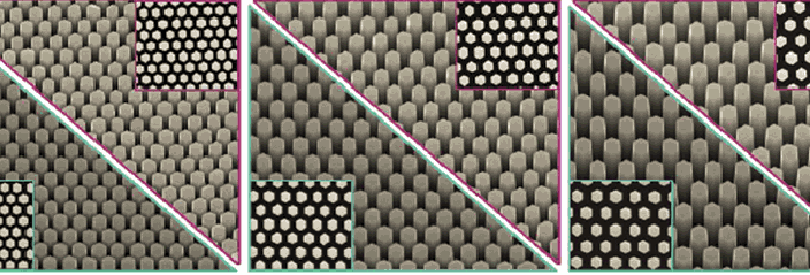This research line investigates oxides in which the advanced functions are based on strong correlations between electrons. In particular, we study how these functionalities can be increased and controlled. The main investigated oxides belong to the family of perovskites for applications in microelectronics. As an example, we have managed to increase the resistivity by three orders of magnitude by varying the thickness from 20 nm to 100 nm in magnetoresistive films composed of La0.7Sr0.3CoO3 [1] and we have succeeded in controlling a selective growth by MOCVD as a function of the temperature in the case of multiferroic films composed of YMnO3 (PhD thesis I. Iliescu). The metal/perovskite interfaces, presenting resistive switching properties, are also studied in collaboration with our partners in order to integrate them into ReRAM memories [2-3] (PhD thesis A. Schulman, K. Maas, R. Rodriguez-Lamas). In collaboration with IST in Portugal (PhD thesis T. Nguyen), we have investigated spinel-type oxides and hydroxides and we have shown the development of different innovative electrodes in the form of thin films for redox supercapacitors [4-5].
Permanent staff
Non permanent staff
Klaasjan Maas (PhD)
Raquel Rodriguez Lamas (PhD)
Raquel Rodriguez Lamas (PhD)
5 selected publications
[1] Z. Othmen et al. Applied Surface Science 306, 60 (2014)
Structural, Electrical, and Magnetic Properties of Epitaxial La0.7Sr0.3CoO3 Thin Films Grown on SrTiO3 and LaAlO3 Substrates
[2] C. Acha et al. Applied Physics Letters 109, 011603 (2016)
Transport Mechanism Through Metal-Cobaltite Interfaces
[3] S. Bagdzevicius et al. Journal of Materials Chemistry C 7, 7580 (2019)
Superposition of Interface and Volume Type Resistive Switching in Perovskite Nanoionic Devices
[4] T. Nguyen et al. Scientific Reports 7, 39980 (2017)
Layered Ni(OH)2-Co(OH)2 Films Prepared by Electrodeposition as Charge Storage Electrodes for Hybrid Supercapacitors
[5] T. Nguyen et al. Energy 126, 208 (2017)
NixCo1-x(OH)2 Sheets on Carbon Nanofoam Paper as High Areal Capacity Electrodes for Hybrid Supercapacitors
Structural, Electrical, and Magnetic Properties of Epitaxial La0.7Sr0.3CoO3 Thin Films Grown on SrTiO3 and LaAlO3 Substrates
[2] C. Acha et al. Applied Physics Letters 109, 011603 (2016)
Transport Mechanism Through Metal-Cobaltite Interfaces
[3] S. Bagdzevicius et al. Journal of Materials Chemistry C 7, 7580 (2019)
Superposition of Interface and Volume Type Resistive Switching in Perovskite Nanoionic Devices
[4] T. Nguyen et al. Scientific Reports 7, 39980 (2017)
Layered Ni(OH)2-Co(OH)2 Films Prepared by Electrodeposition as Charge Storage Electrodes for Hybrid Supercapacitors
[5] T. Nguyen et al. Energy 126, 208 (2017)
NixCo1-x(OH)2 Sheets on Carbon Nanofoam Paper as High Areal Capacity Electrodes for Hybrid Supercapacitors
Review article
[1] S. Bagdzevicius et al. Journal of Electroceramics 39, 157 (2017)
Interface-Type Resistive Switching in Perovskite Materials
Interface-Type Resistive Switching in Perovskite Materials
Projects
ANR ALPS_MEMORIES (2016-2019, coordinator : C. Jiménez) in collaboration with the research line Oxides for Nanoionic Devices
Type : Research National Agency, collaborative program call
Title : Alternative perovskite materials for ReRAM memories: understanding and tailoring resistive switching
Partnership : IMEP-LAHC (Grenoble), CEA-LETI (Grenoble), UCCS (Lille)
Type : Research National Agency, collaborative program call
Title : Alternative perovskite materials for ReRAM memories: understanding and tailoring resistive switching
Partnership : IMEP-LAHC (Grenoble), CEA-LETI (Grenoble), UCCS (Lille)
National & international collaborations
- Institut Néel, Grenoble
- ESRF, Grenoble
- IMEP-LAHC, Grenoble
- CEA-LETI, Grenoble
- UCCS, Lille
- Centrale Supélec, Université Paris-Saclay
- LBT/FCEyN-UBA, Buenos Aires (Argentina)
- FI-UBA, Buenos Aires (Argentina)
- AIST, Tsukuba (Japan)
- IST, Lisbonne (Portugal)
- ICN2, Barcelona (Spain)
- LPCM FSM, Monastir (Tunisia)



